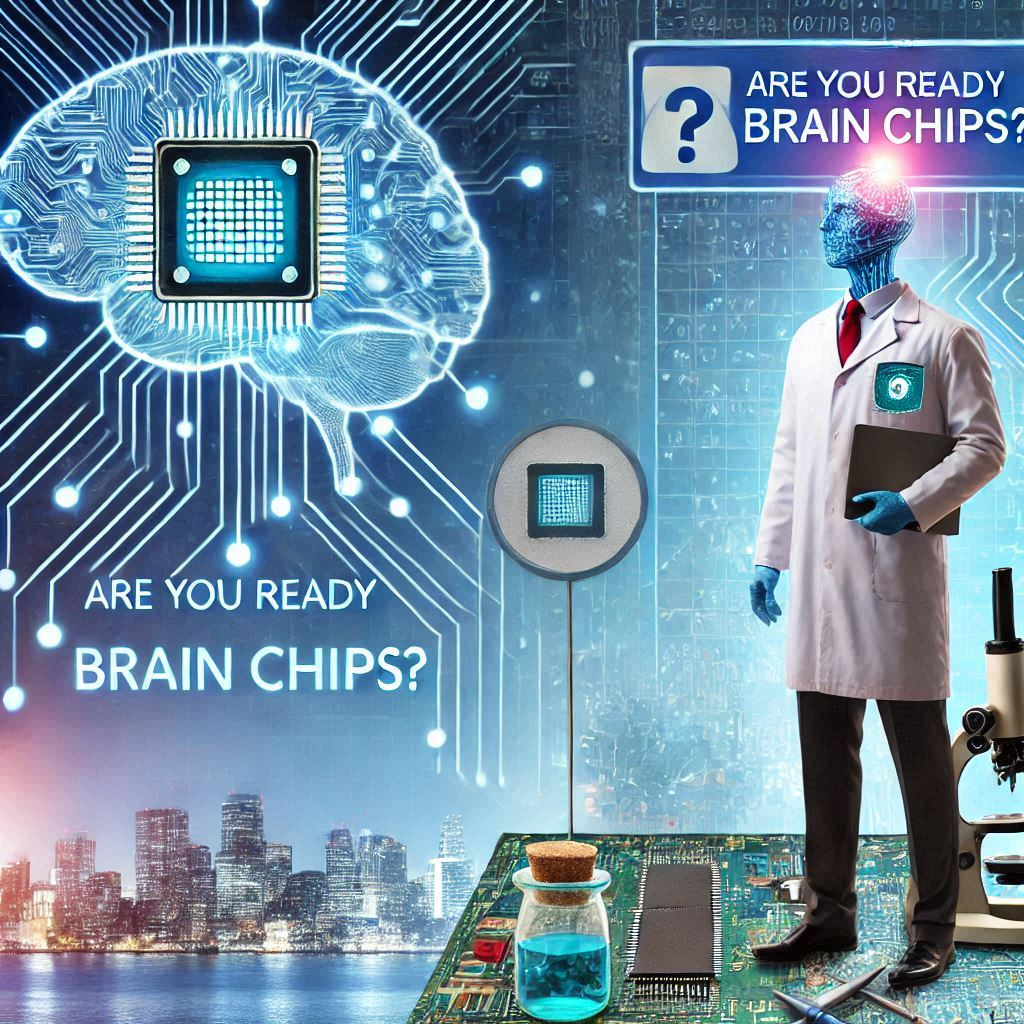
Exploring How Neural Implants Could Change the Way We Live
Neural implants, or brain-computer interfaces (BCIs), could totally transform our everyday lives. Imagine controlling devices like your phone or computer just by thinking! These implants work by connecting your brain to technology, allowing you to communicate or perform tasks without using your hands or voice. This could be a game-changer for people with disabilities, offering new ways to interact with the world.

In the future, BCIs might help us learn faster, improve memory, or even allow us to experience virtual worlds directly in our minds. But the technology still needs to overcome a few challenges, like making sure it’s safe and comfortable for long-term use.
While we’re not quite there yet, the idea of neural implants could lead to a world where technology is seamlessly integrated into our brains, making everyday tasks easier and opening up new possibilities for how we work, play, and connect with others. It’s an exciting step toward the future!
Can Brain-Computer Tech Make Us Smarter or Just More Connected?
Brain-computer technology, especially neural implants, has the potential to change our brains and how we interact with the world. But the big question is: can it make us smarter or just more connected? These implants allow us to control devices with our minds, giving us a new level of convenience. For example, someone with a disability might use a brain implant to control a prosthetic limb.

On the other hand, there’s concern that instead of making us smarter, it might just keep us more connected to technology, increasing screen time and dependence on devices. Imagine being able to access information directly from your brain without searching through a phone or computer. While that sounds exciting, it could also mean we’re constantly linked to technology, potentially leading to distractions or even a loss of mental privacy.
So, while brain implants could boost our abilities, we still need to think about how they’ll impact our daily lives and relationships with technology.
How Close Are We to Using Brain Chips in Everyday Life?
Brain chips, or neural implants, are no longer just science fiction. In recent years, technology has made huge strides, and we’re closer than ever to using brain-computer interfaces (BCIs) in our daily lives. These devices can connect our brains to computers, allowing us to control gadgets, enhance memory, or even communicate without speaking. Companies like Neuralink are testing prototypes, showing that these chips can help with medical issues, like paralysis or memory loss.

However, we’re still a few years away from seeing brain chips used widely. Right now, most BCIs are in the testing phase or used only in special medical cases. The big challenge is making them safe, easy to use, and affordable. As researchers improve the technology, we might see everyday applications, like controlling your phone with just your thoughts or even enhancing brain function. But until then, we’re still waiting for these chips to become part of our normal routine.
The Promise and Potential of Neural Implants for Health and Work
Neural implants, or brain-computer interfaces (BCIs), are a promising new technology that could revolutionize both health and work. These implants allow the brain to communicate directly with computers, opening up exciting possibilities. In healthcare, BCIs could help people with disabilities regain lost functions, like controlling prosthetic limbs or even restoring speech. They might also assist in treating conditions like epilepsy or paralysis by stimulating specific brain areas.

In the workplace, neural implants could enhance productivity by allowing us to control devices just by thinking, eliminating the need for keyboards or even voice commands. They could also be used to help people learn faster by directly transmitting information to the brain. The potential is huge, but we’re still in the early stages of development. While the promise is strong, there are still challenges to overcome, like safety concerns and ensuring accessibility for everyone. However, the future looks bright for these groundbreaking technologies.
Will Brain-Computer Interfaces Help Us Control Technology with Our Minds?
Brain-computer interfaces (BCIs) are technology that allow us to control devices using just our thoughts. Imagine being able to turn on a light, play music, or even type a message just by thinking about it. This might sound like science fiction, but with advances in neural implants, it’s becoming more possible every day. BCIs work by detecting electrical signals in the brain and translating them into actions on a computer or device. For example, people with physical disabilities are already using BCIs to control prosthetics or communicate more easily.

However, making this technology widely available is still a work in progress. While it’s promising, there are challenges like ensuring the technology is safe, affordable, and comfortable for regular use. But in the future, BCIs could give us the ability to interact with technology in ways we’ve never imagined before. It’s an exciting step towards merging our minds with the devices we use every day.
What’s Stopping Neural Implants from Going Mainstream?
Neural implants, or brain-computer interfaces, have the potential to revolutionize how we interact with technology. However, there are several obstacles keeping these devices from going mainstream. First, the technology is still in its early stages. While some prototypes exist, they’re not yet reliable or safe for everyday use. Many people worry about the risks of having a device implanted directly into the brain, especially regarding long-term effects and potential malfunctions.

Another issue is the cost. Developing and manufacturing neural implants is expensive, making them out of reach for most people. Plus, there are ethical concerns about privacy and control. The idea of a device that can read and influence our thoughts raises important questions about security and freedom.
Finally, the lack of regulations and standards makes it harder to roll out this technology safely. Until these challenges are addressed, neural implants might remain more of a futuristic concept than a mainstream tool.
How Safe Are Neural Implants for Regular People?
Neural implants, or brain-computer interfaces (BCIs), have the potential to revolutionize how we interact with technology. But one of the biggest concerns is safety. Right now, these devices are mainly used in medical settings, like helping people with disabilities control prosthetics or communicate. While the technology is improving, it’s not without risks.

For regular people, the idea of implanting a chip into your brain can sound scary. There’s always the risk of infection, brain damage, or long-term side effects, especially since the technology is still relatively new. However, many researchers are working hard to make sure these implants are as safe as possible. They’re testing smaller, less invasive designs, and improving surgical techniques. Still, it’s important to be cautious and weigh the benefits against potential risks. As the technology matures, it’s likely that BCIs will become safer, but for now, they’re best suited for those with specific medical needs.
The Future of Tech: Can Your Brain Control Gadgets Soon?
In the near future, brain-computer interfaces (BCIs) might make it possible for us to control gadgets just by thinking. Imagine being able to turn on your TV, adjust the lights, or even play games with nothing but your mind. This is the idea behind neural implants, tiny devices that connect directly to the brain and interpret your thoughts into actions.

Right now, researchers are working hard to make this tech a reality. While BCIs are still in the early stages, they’ve already been used to help people with disabilities, allowing them to control prosthetic limbs or even communicate with others using just their thoughts.
But will we all be using BCIs in our daily lives soon? There are still challenges, like making the technology safe and affordable for everyone. However, with rapid advancements in science and tech, it’s not too far-fetched to imagine a future where gadgets respond to your brainwaves instead of a remote or touch screen.
From Sci-Fi to Reality: How Neural Implants Could Improve Lives
Neural implants, once a concept from science fiction, are quickly becoming a reality. These small devices, connected directly to the brain, can open up exciting new possibilities for improving our daily lives. Imagine being able to control devices just by thinking about them, whether it’s turning on a light, typing on a screen, or even controlling a robotic arm. This technology has the potential to help people with disabilities regain independence by giving them control over their bodies or allowing them to communicate more easily.

Beyond medical uses, neural implants could also enhance our cognitive abilities. For example, they might help people learn faster, improve memory, or even boost creativity. Although we’re still in the early stages, researchers are making impressive strides. In the near future, neural implants could become as common as smartphones, offering new ways to connect with technology and improve our quality of life. The future is looking incredibly promising for this sci-fi technology.
Are We Ready for Brain Chips in Our Daily Lives?
Are we ready for brain chips in our daily lives? It might sound like something from a sci-fi movie, but brain-computer interfaces (BCIs) are slowly becoming a reality. These devices could allow us to control technology directly with our thoughts, making everyday tasks easier and faster. Imagine controlling your phone or computer just by thinking, or even helping people with disabilities regain some lost functions.

However, there are still many questions to answer before BCIs become common. First, we need to ensure they’re safe and secure, so hackers can’t access our thoughts. We also have to think about privacy—how much of our brain activity should be shared? Plus, there’s the issue of cost. Right now, brain chips are expensive and not widely available.
While it’s exciting to think about a future where brain chips are part of our daily lives, we may need a few more years to fully trust and adopt them.




